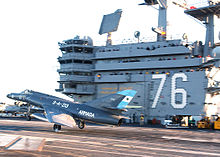- Touch-and-go landing
-
 Argentine Super Etendard commencing a touch-and-go landing on the USS Ronald Reagan during Gringo-Gaucho.
Argentine Super Etendard commencing a touch-and-go landing on the USS Ronald Reagan during Gringo-Gaucho.
In aviation, a touch-and-go landing or circuit is a manoeuvre that is common when learning to fly a fixed-wing aircraft, although there is some debate as to whether there is much benefit. It involves landing on a runway and taking off again without coming to a full stop. Usually the pilot then circles the airport in a defined pattern known as a circuit and repeats the manoeuvre. This allows many landings to be practised in a short time.[1] It can also describe a maneuver used to test questionable landing surfaces.
If the pilot brings the aircraft to a full stop before taking off again then it is known as a "stop-and-go".
In British parlance this maneuver is called "circuits and bumps".[2]
Contents
Standard procedure
The standard circuit begins with a roll down the runway until the aircraft rotates, a climb out to TPA (traffic pattern altitude), a right or left climbing turn (depending on making either right hand or left hand circuits) to 500 feet above ground level perpendicular to the runway, continuing gaining altitude up to 1000 feet AGL, followed by another right or left turn for a downwind leg parallel to the runway, maintaining 1000 feet AGL. During the downwind leg the pilot completes pre-landing checks and contacts the control tower advising a full stop landing or a touch-and-go. After seeing the threshold of the runway at 45 degrees behind him/her, the pilot makes another left or right turn descending to 500 feet AGL. The pilot then turns on the last leg, the final approach where clearance to land or for a touch-and-go is expected.
In an uncontrolled airport, the pilot announces position and intent over a UNICOM or a CTAF radio frequency to coordinate the flow of local air traffic between the pilots.
Debate over role in flight instruction
Some flight instructors believe touch-and-goes should not be so heavily used, if at all, with student pilots. They argue that it results in less attention being paid to learning to land properly, and thus creates safety problems. Neither the Federal Aviation Administration's Practical Test Standards nor its Airplane Flying Handbook discuss touch-and-goes, they note.[3]
Instructors who favor the use of touch-and-goes respond that it makes it possible to practice more landings per hour of instruction. Students doing touch-and-goes find it easier to master landing, particularly the final stage known as landing flare, which is often difficult to learn. Preparing to take off while landing is a necessary safety skill, they add, since any pilot must be able to do it in order to reject a landing.[3]
References
- ^ Teaching Touch And Goes
- ^ "Circuits and Bumps" book
- ^ a b Bergqvist, Pia (August 2011). "The Touch-and-go: Are touch-and-goes a good idea during flight training?". Flying 138 (8): 36.
External links
 Media related to Touch-and-go at Wikimedia Commons
Media related to Touch-and-go at Wikimedia Commons
Takeoff and landing Takeoff Assisted take off · Balanced field takeoff · CATO · CATOBAR · CTOL · JATO · Non-rocket spacelaunch · Rejected takeoff · Rocket launch · STOBAR · STOL · STOVL · V/STOL · VTOHL · VTOL · VTVL · Zero length launch
Landing Belly landing · Crosswind landing · Deadstick landing · Emergency landing · Forced landing · Hard landing · Short-field landing · Splashdown · Touch-and-go landing · Water landing / Ditching
Categories:- Aviation terminology
- Types of take-off and landing
Wikimedia Foundation. 2010.
